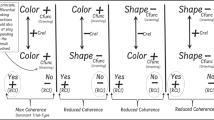Abstract
Three experiments were devised involving 176 subjects aged between 5-0 and 8-1 years to examine children's receptive control of a set of four intersentence relations (identity, antonymy, structure reversal, equivalence) and to relate this linguistic ability to levels of cognitive functioning as assessed by the Piagetian measureDeux Sens de l'Orientation. The results indicate a significant but moderate correlation between performance on the two tasks. Cognitive precedence with respect to corresponding linguistic ability was observed in only one of the experiments, where linguistic performance was unsually low due to phonological interference between the lexical items used. The results were interpreted as giving evidence of linguistic reversibility—partially independent from cognitive reversibility though isomorphic with it—in the perceptual-figurative mode, resulting in flexible and efficient processing of linguistic inversions and even converse relations by preoperational children. These data complement previous psycholinguistic research in the Piagetian tradition, which had shown cognitive precedence relative to corresponding linguistic processes. It is suggested that previous research had tapped mainly linguistic processes in the cognitive operational mode, and that future research needs to examine the interrelation between the two modes.
Similar content being viewed by others
Reference Notes
Beilin, H., & Spontak, G.Active-passive transformations and operational reversibility. Paper presented at the Biannual Meeting of the Society for Research in Child Development, Santa Monica, 1969.
Sack, H. G., & Beilin, H.Meaning equivalence of active-passive and subject-object-first cleft sentences. Presented at the Development Psycholinguistics Conference, Buffalo, 1971.
References
Beilin, H.Studies in the cognitive basis of language development. New York: Academic Press, 1975.
Bronckart, J.-P.Genèse et organisation des formes verbales chez l'enfant. Brussels: Dessart & Mardaga, 1976.
Bronckart, J.-P.Théories du langage: Une introduction critique. Brussels: Dessart & Mardaga, 1977.
Clark, E. V. On the Child's acquisition of antonyms in two semantic fields.Journal of Verbal Learning and Verbal Behavior, 1972, II, 750–758.
Ferreiro, E.Les relations temporelles dans le langage de l'enfant. Geneva: Droz, 1971.
Karmiloff-Smith, A. The interplay between syntax, semantics and phonology in language acquisition processes. In R. N. Campbell & P. T. Smith (Eds.),Recent advances in the psychology of language.. New York: Plenum Press, 1978.
Karmiloff-Smith, A.A functional Approach to child language. Cambridge: Cambridge University Press, 1979.
Laurendeau-Bendavid, M., Pinard, A., & Boisclair, C. Lavallee, M.Echelle de développement de la pensée opératoire.. Submitted for publication.
Lavallée, M.Acquisition d'une deuxième langue et développement opératoire chez l'enfant. Unpublished doctoral dissertation, Université de Genève, 1973.
Lefebvre, M., & Pinard, A. Apprentissage de la conservation des quantités par une méthode de conflit cognitif.Canadian Journal of Behavioral Science, 1974,6, 398–413.
McNeill, D. The two-fold way for speech. InProblèmes actuels en psychololinguistique. Paris: CNRS, 1974.
Piaget, J.Les notions de mouvement et de vitesse chez l'enfant. Paris: Presses Universitaires de France. 1946.
Sinclair-DeZwart, H.Acquisition du language et développement de la pensée. Paris: Dunod, 1967.
Sinclair-DeZwart, H. Developmental psycholinguistics. In D. Elkind & J. Flavell (Eds.),Studies in cognitive development. New York: Oxford University Press, 1969.
Sinclair-DeZwart, H. L'apport de la théorie de Piaget à l'étude, de, l'acquisition du langage.Cahiers de l'Institut Linguistique de Louvain, 1978,5(1/2), 29–40.
Sinclair-DeZwart, H., & Ferreiro, E. Production et répétition des phrases au mode passif.Archives de Psychologie, 1970,40, 1–42.
Trabasso, T. Memory and transitive inferences. In R. V. Kail & J. W. Hagen (Eds.),Perspectives in development of memory and cognition. Hillsdale, New Jersey: Erlbaum, 1977.
Author information
Authors and Affiliations
Additional information
This research was supported by an operating grant awarded to the author by the Natural Sciences and Engineering Research Council, Canada (A-9786), and by a postdoctoral fellowship awarded by the Canada Council (W 750514). The valuable assistance provided by members of the Laboratoire de Psychologie et d'Epistémologie Génétique at the Department of Psychology, Université de Montréal, where the author spent a year of postdoctoral studies, is gratefully acknowledged. Gratitude is also expressed to Monique Lefebvre-Pinard for helpful comments on the manuscript. We further acknowledge the cooperation of the Montreal Catholic School Board and the staff of Ecole Jean Nicolet, Ecole Saint-Isaac-Jogues, Ecole Cardinal Léger, Ecole Sainte-Louise-de-Marillac, and Ecole Saint-Jean-de-Matha in Montreal.
Rights and permissions
About this article
Cite this article
Feider, H. Does linguistic reversibility exist? an experimental exploration of a psycholinguistic construct. J Psycholinguist Res 11, 19–33 (1982). https://doi.org/10.1007/BF01067499
Accepted:
Issue Date:
DOI: https://doi.org/10.1007/BF01067499



